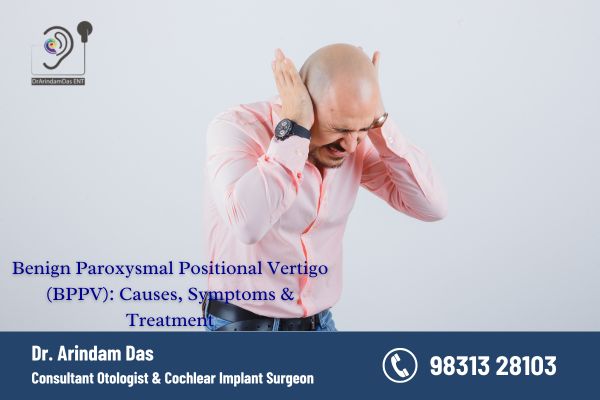Benign Paroxysmal Positional Vertigo (BPPV): Causes, Symptoms & Treatment
Benign Paroxysmal Positional Vertigo (BPPV) is one of the most common inner ear disorders that causes sudden episodes of vertigo (a spinning sensation). Though not life-threatening, it can significantly affect daily life, causing dizziness and imbalance. With expert treatment from Dr. Arindam Das, patients can find effective relief and regain stability.
What is BPPV?
BPPV occurs when tiny calcium particles (otoconia) become dislodged and move into the semicircular canals of the inner ear. These misplaced crystals disrupt the normal balance signals sent to the brain, leading to vertigo when the head moves.
Common Causes of BPPV
BPPV often happens without a clear cause, but some factors may contribute to it:
✔ Aging – More common in individuals over 50.
✔ Head Trauma – A blow to the head can disturb inner ear structures.
✔ Inner Ear Infections – Can disrupt balance mechanisms.
✔ Prolonged Bed Rest – Lack of movement can lead to calcium buildup.
✔ Meniere’s Disease – Affects inner ear fluid balance, sometimes triggering BPPV.
Symptoms of BPPV
BPPV symptoms are triggered by head movements and can include:
🔹 Sudden vertigo (spinning sensation).
🔹 Dizziness and imbalance.
🔹 Nausea or vomiting (in severe cases).
🔹 Difficulty focusing or walking.
🔹 Brief episodes lasting seconds to a minute.
These symptoms may worsen when getting out of bed, tilting the head, or turning quickly.
How is BPPV Diagnosed?
Dr. Arindam Das uses specialized tests to diagnose BPPV, such as:
✔ Dix-Hallpike Test – A positioning test that triggers vertigo for diagnosis.
✔ Eye Movement Analysis – To check for abnormal eye jerks (nystagmus).
✔ MRI/CT Scans – To rule out other balance-related disorders if needed.
Treatment Options for BPPV
1. Canalith Repositioning Maneuvers (Epley Maneuver)
The Epley Maneuver is a series of guided head movements that reposition the dislodged crystals back to their correct place in the inner ear. It provides relief for most patients within one or two sessions.
2. Vestibular Rehabilitation Therapy (VRT)
For recurring BPPV, VRT exercises help retrain the brain to manage balance more effectively. These include:
✅ Brandt-Daroff Exercises – Simple movements done at home to reduce dizziness.
✅ Gaze Stabilization Techniques – Improve balance and reduce motion sensitivity.
3. Medications for Symptom Relief
While medications do not cure BPPV, they can help with dizziness and nausea:
💊 Antihistamines (Meclizine, Betahistine) – Reduce vertigo.
💊 Anti-nausea Drugs (Ondansetron) – Help control vomiting.
4. Surgery (Rare Cases)
If severe and persistent, posterior canal occlusion surgery may be considered, though it is rarely needed.
Preventing BPPV Recurrence
While BPPV cannot always be prevented, certain lifestyle changes may help:
✔ Avoid sudden head movements or jerks.
✔ Sleep with your head slightly elevated.
✔ Stay hydrated and maintain good ear health.
✔ Do balance exercises regularly.
When to See a Specialist?
If you experience frequent vertigo episodes, loss of balance, or dizziness affecting daily life, consult Dr. Arindam Das for an expert evaluation and treatment plan.
Conclusion
BPPV is a treatable condition with non-invasive maneuvers and therapy. With the right guidance from Dr. Arindam Das, patients can effectively manage and overcome vertigo. If you’re experiencing dizziness, seek expert care today!

